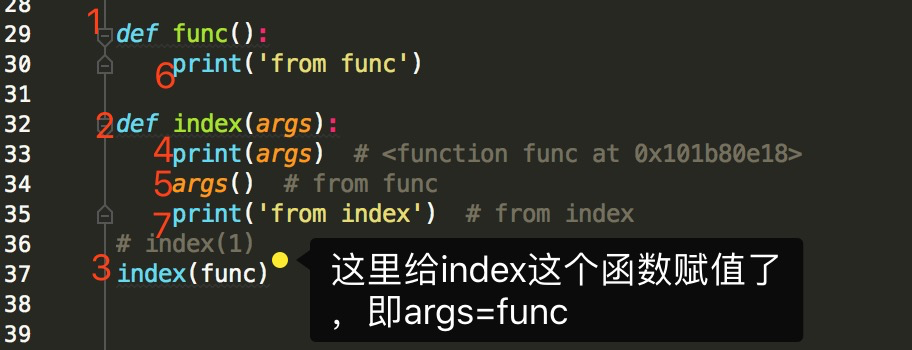函数是第一类对象:函数名指向的值可以被当做参数传递
在python中,所有变量存放的值只要是地址,我们就称之为对象。
——所有变量都是用来存放地址的,所以都是对象
——存放整型的地址就是整型对象,存放函数的地址就是函数对象,
存放文件的地址就是文件对象
函数对象:存放函数地址的变量就是函数对象
def func(): # 这里的func就是函数对象 pass
1.函数名可以被传递
name = 'bitten' x = name print(x) # bitten print(id(x)) # 4537026352 def func(): print('from func') print(id(func)) # 4536540696 f = func # 函数名可以传递,下面f就等价于func print(func) # <function func at 0x10154ae18> func() # from func print(f) # <function func at 0x10e974e18>
# 其实指向的也是函数func指向函数体代码的内存地址
f() # from func
2.函数名可以被当做参数传递给其他函数
def func(): print('from func') def index(args): print(args) # <function func at 0x101b80e18> args() # from func print('from index') # from index index(func)

3. 函数名可以被当做函数的返回值
def index(): print('index') def func(): print('func') return index res = func() # func print(res) # <function index at 0x108027e18> res() # index
4. 函数名可以被当做容器类型的参数
def register(): username = input() pwd = input() def login(): print('login...') msg =''' 1.注册 2.登录 ''' func_dict = { '1':register, '2':login, } while True: print(msg) choice = input('请选择要执行的功能>>>:').strip() # 去空格 if choice in func_dict: func_dict.get(choice)() else: print('没有该功能')